Transplant Digest
Spring/Summer 2023
Issue No. 34
SPRING/SUMMER 2021
ISSUE NO. 30

Spring/Summer 2023
Issue No. 34
SPRING/SUMMER 2021
ISSUE NO. 30
Maureen
In this issue...
In this issue...
Connelly, RNDr.
Jeff ZaltzmanWe celebrated World Kidney Day on March 9th, joining a global community campaign aimed at raising awareness of the importance of our kidneys. World Kidney Day is a joint initiative of the International Society of Nephrology (ISN) and the International Federation of Kidney Foundations – World Kidney Alliance (IFKF-WKA).
The logo for World Kidney Day is composed of two kidneys and three bright color bars. These colors represent the blood (red), excess water (blue), and urine (yellow) that our kidneys filter, clean, and eliminate.

At the time of writing, approximately 50% of Canadians received at least one dose of a Health Canada-approved vaccine, and 3% received a second dose. Product monographs for the two mRNA vaccines, Pfizer-BioNTech, and Moderna, recommend a second dose at 21 and 28 days respectively. The recommended second dose for the virus vector vaccine by Astra Zeneca is between 10-12 weeks following the first. The other approved virus vector vaccine by Johnson and Johnson requires only a single dose. What have we done in Canada with respect to vaccine rollouts?
The WKD mission aims to raise awareness of the importance of our kidneys to our overall health and to reduce the frequency and impact of kidney disease and its associated health problems worldwide. WKD started in 2006 and has grown tremendously ever since. Each year highlights a different theme. This year’s theme is “Kidney Health for All - Prepar-
Owing to world-wide demand and supply limitations, Canada had a slow and tumultuous vaccine procurement early on. None of the COVID-19 vaccines are manufactured in Canada,
Continued on page 2
Continued on page 2
• World Kidney Day
• From the Editor’s Desk
• COVID-19 Vaccines and the Canadian Landscape
• Understanding if COVID-19 Vaccines are Effective
• Contact Information
• White Blood Cells and Transplantation
• Preparing for your Virtual Clinic Visit
• Your Lab Requisition
• Managing blood sugar
• Having a baby after a kidney transplant
• A conversation with Hockey Star
David Ayres
• How to Cope in a Busy Clinic
• How much water should you drink each day?
• Thinking Traps
• Iron Deficiency after Transplant
• My CPAP Journey
• Post Transplant Chat : Knowing your medication
• Patient Advocacy at Its Best: Transplant Program’s Request for BP Cuff Funding Gets Approved by the Kidney Foundation of Canada
• Events
• Adjusting Transplant Research Participation to Pandemic Limitations
• Transplant Quiz
• Writing to your donor family
Welcome to the Spring/Summer 2023 edition of Transplant Digest. We are settling in to our new clinic space on the 8th floor of 61 Queen Street East, with all its brand new facilities, and hope you have had a chance to either visit the new clinic or take a peak. As the COVID-19 pandemic hopefully draws to a close, we are actively planning for how we can manage increased patient numbers, and increased patient complexity. Remember, new transplant activity hardly stopped during the pandemic! We now have over 1800 patients. Fortunately, most (but not all) of our immunosuppressed patient population survived the pandemic, but we can’t afford to take anything in life for granted. Please keep your vaccination up to date.
In this issue, we have articles on white blood cells, thinking traps, World Kidney Day, blood pressure monitoring cuffs, and managing blood sugar, as well as a transplant quiz and a special interview with kidney transplant recipient and hockey star David Ayres. We are always looking for contributions from patients, so please feel free to contact us with your ideas if you like to write and are passionate about something transplant-related. Transplant Digest is all about you.
World Kidney Day story
continued from page 1
ing for the unexpected, supporting the vulnerable”. The following journal article summary showcases the increase in natural disasters that have the potential to disproportionably affect individuals with kidney disease:
Kidney health for all: preparedness for the unexpected in supporting the vulnerable
As the rate of natural disasters and other devastating events caused by human activities increases, the burden on the health and well-being of those affected by kidney disease has been immeasurable. Health system preparedness, which involves creating a resilient system that is able to deal with the health needs of the entire community during times of unexpected disruptions to usual care, has become globally important. In the wake of the COVID-19 pandemic, there is a heightened awareness of the amplification of negative effects on the renal com-
Dr. Ramesh Prasad – Editor
Meriam Jayoma-Austria, RN, BScN, C.Neph.CNewsletter Coordinator
Please send your comments or suggestions of topics for future publication to: meriam.jayoma@unityhealth.to
St. Michael’s Hospital Kidney Transplant Program
(across the hospital)
61 Queen Street East, 9th Floor Toronto, Ontario, M5C 2T2 Phone: 416-865-3665
Views presented in this newsletter are those of the writers and do not necessarily reflect those of St. Michael’s Hospital or the University of Toronto. Subject matter should not be construed as specific medical advice and may not be relevant. For all questions related to your health please contact your health care provider.
munity. Paradoxically, the complex medical needs of those who have kidney diseases are not met by systems handling crises, often compounded by an acute increase in burden via new patients as a result of the crisis itself. Disruptions in kidney care as a result of unexpected events are becoming more prevalent and likely to increase in the years to come. It is therefore only appropriate that the theme for this year’s World Kidney Day will focus on Kidney Health for All: preparedness for the unexpected in supporting the vulnerable.
Transplantation services and donation chains in times of crisis are placed on hold, creating disruption for patients urgently awaiting the procedure. (Canadian Blood Services suspended Kidney Paired Donation during the early COVID pandemic) Patients living with a functioning graft or with chronic kidney disease of various forms may experience unavailability immunosuppressive medications. A sudden high demand for acute dialysis may impact dialysis availability for patients on chronic dialysis. If patients are forced to flee, these challenges are aggravated by unsafe and precarious conditions during their journey and/or at their destination.
The crisis itself does not only affect patients with pre-existing kidney disease. In fact, it may lead to significant numbers of patients with acute kidney

injury, such as crush injury, which for instance can result in acute kidney injury (AKI) or kidney failure, adding an additional burden to units.
In case of an emergency, it is important for patients to be prepared and informed on how to react in case of emergencies. Hemodialysis and transplant patients should:
• Plan of an emergency; this can help save their lives. Prepare an emergency checklist.
• Obtain prescriptions ahead of time. Keep a list of their medical needs, medicines, and dosages.
• Maintain a list of important contact information i.e., phone numbers of back-up dialysis units, doctors, different options of dialysis units and Emergency Medical Services.
• Keep a two-week extra supply of their required medicines in their original bottles and keep a 7–14-day emergency diet stock.
• Prepare an emergency kit in a waterproof bag (containing key information and items, such as a medicine list, doctor, transplant coordinator, pharmacist, insurance, bottles of water, and other supplies. “
Further emergency preparedness information is available on the National Kidney Foundation website.
One of the most important tests monitored in the post-transplant patient is the complete blood count, or CBC. Within the CBC, one of the important tests is the white blood cell, or WBC count. Although the normal range varies somewhat depending on the laboratory, the normal total WBC count is considered as between 4000 and 11,000/mm3. Within the WBC are five distinct classes of cells, called neutrophils, lymphocytes, monocytes, eosinophils, and basophils. Neutrophils and lymphocytes are the most common and the ones most closely monitored, although the others can also be important in certain situations.

Neutrophils increase in response to infection, typically bacterial, as well as in response to stress and steroids. A rise in neutrophils usually means the total WBC count is elevated as well. It is quite common to see a rise in neutrophils early after the transplant from stress and steroids alone. However, if there are symptoms like fever or burning in the urine, then infection is definitely possible. A low neutrophil count (neutropenia) can occur in viral infection, and because of certain medications. This is not dangerous unless the count is very low, in which
case other medications can be used to stimulate neutrophil production.
Increased lymphocytes (lymphocytosis) results from viral infections, and rarely cancer. Neutrophil and lymphocyte counts often move in opposite directions, so if one is high, the other may appear low. A low lymphocyte count may be due to certain medications, autoimmune disorders, malnutrition, and more recently with COVID-19 infection.
As for the remaining three types of WBC, monocytosis occurs in autoimmune disease, certain cancers, infections like tuberculosis, and inflammatory bowel disease. Monocytopenia can occur from cancer and cancer drugs, and aplastic anemia. Eosinophilia typically results from allergic reactions, but can be seen in parasitic diseases and autoimmune disorders. Basophilia also relates to infections, allergies, and chronic inflammation, but is rare.
Please do not hesitate to ask us in the Transplant Clinic if you have any question regarding your WBC count.
Blood sugar management is important after kidney transplant because it helps to protect your new kidney. After transplant, you may be prescribed steroid medications like Prednisone as part of your anti-rejection medications. Those taking prednisone can experience higher blood sugars, this is a concern for those with and without diabetes. One strategy to manage blood sugars is by managing your sugar intake.
Sugar is found in many foods, both naturally or added. Sugar provides energy (calories) but has no nutritional value on its own. Sugar comes in many forms: white sugar, brown sugar, molasses, honey, maple syrup and corn sweeteners. On a food label ingredient list sugar may be listed as: glucose, fructose, dextrose, maltose, sucrose. These sugars are called “free sugars” or “added sugars”. Free sugars are sugars added to food products, and sugar naturally present in honey, syrups, fruit juices and purées.
Some foods that naturally contain sugar, such as grain products (e.g. bread, rice, pasta), vegetables, fruit, and dairy products (e.g. milk, yogurt), are an important part of a healthy diet, because they also contain essential nutrients.
The Heart & Stroke Foundation recommends to consume no more than 10% total calories per day from added sugars, and ideally less than 5%. For an individual on an average 2,000 calorie-a-day diet,
5% of calories is about 28 grams (or 6 teaspoons) of added sugars.
To put that into perspective, let’s take a look at some examples:
• One can of pop contains about 85% (or approx. 10 teaspoons) of daily added sugar.
• One cup of juice contains 5 teaspoons of added sugar.
Foods that naturally contain sugar such as vegetables, fruit and milk should be included in a healthy diet in reasonable quantities. Managing your weight, healthy eating habits, and being active can help you manage your blood sugars. Here are some tips for managing your sugar intake:

Don’t drink your calories. Choose water as your beverage of choice. Add flavoring like strawberries or lemon to change up the taste.
Include whole foods. Enjoy a piece of fruit like a clementine or apple instead of juices. This helps to provide you with vitamins and fibre in addition to quenching your thirst.
Look for lower sugar foods. Read food labels and choose foods with 5% Daily Value or less for sugar.
David Ayres is a Canadian former professional ice hockey goaltender, the oldest to win in his regular season debut. He became the Carolina Hurricanes’ emergency goaltender during a 2020 National Hockey League (NHL) game against the Toronto Maple Leafs. Despite having never played in the NHL before and being 42 years of age, he and Carolina won the game. David received his living related kidney transplant at St. Michael Hospital in 2004. David recently conversed with Dr. Prasad about how his hockey career fit with his kidney transplant.
Dr. Prasad: Thank you for sharing aspects of your life with a kidney transplant. When you first came to us for an assessment, you were on dialysis. How was life on dialysis?
David: Having played hockey my whole life, I was still very committed to playing. I just wanted to play. I even played with a dialysis line in my neck! Staying hydrated just enough was challenging, because I didn’t sweat. I was on dialysis for 8 months before the transplant.

Dr. Prasad: I remember you were very determined to play hockey after the transplant.
David: Yes, we discussed how best to protect the kidney afterwards. I consulted with a few experts to make sure the kidney was very well-protected during practice and games.
Dr. Prasad: The transplant operation went well. What did it feel like afterwards?
David: I felt great! I was back in the gym in 3 months, and was back on the ice in 5 months.
Dr. Prasad: What was it like to be playing hockey again?
David: I did take a few shots to the stomach, but felt fine. I was back to 100%. I also played baseball to stay fit. I missed some time due to an ankle injury, but I never called in sick in 8 years! I was mentally always there. Of course, I had great transplant doctors and nurses to help me along the way.
Dr. Prasad: That’s very kind. Did your teammates know you had a kidney transplant?
David: Some knew about it and some didn’t. They had no idea about transplants or how they work. They did appreciate my need to take medication. I didn’t feel different from anybody else.
Dr. Prasad: What special precautions do you have to take in order to play?
David: Staying hydrated is very important. I have to drink a lot of fluids, otherwise I could get cramps. I also have to consume enough calories to stay healthy. No alcohol. The fistula and the kidney are shielded with lots of padding.
Dr. Prasad: What is your advice to transplant patients who want to play high-level sports as you do?
David: Go for it! Do not doubt the process. Trust the experts, because they know what they are doing.
Edited
for clarity of content. Dr. Ramesh Prasad
Dr. Ramesh Prasad
You might have noticed that the post-transplant clinics keep getting busier by the day. There are more and more patients who need to be seen, and sometimes clinics are overbooked. Waiting times in the sitting are can be very long, and that is after a long, expensive, and difficult commute to come to the clinic. You may be tired, thirsty, and hungry. The running television program is boring. There are no magazines lying around. Telephone visits are no longer a reliable option. What can you do?
Do your laboratory testing before the appointment, so it will be one less thing to worry about on appointment day. Ensure everything is set out for your appointment the night before, including paperwork, purse, clothing, etc... The less you have to run around looking for things at the last minute, the less stress you will have during your trip over to the clinic. Build time in before the appointment if possible to do something relaxing.
After you arrive, please don’t forget to check in at the reception. Often people forget to let the office personnel know that they are present.
Always bring something to do with you to your office visit. SMH has free Wi-Fi available so you can work while waiting. Clear your schedule on the appointment day if you can, so that the appointment becomes the only stressor you have for the day. Distract yourself in the waiting room with a novel or a game. Visit the learning centre right across the hallway, where you can peruse the brochures or use the computer. Write down the issues you wish to discuss if you have not done so already. Bring along a water bottle and a small snack, especially if you have diabetes.
During the appointment, be willing to take a breath and tell the nurse or doctor you need a moment to gather your thoughts. After the appointment, again do something calm and enjoyable. Don’t rush life if you don’t have to. There is more to life than increasing its speed.
As the wise man once said, “a visit to the doctor is never a social visit”. On our part, we will try to make this non-social visit as pleasant as possible.
You’ve probably heard about sound distortion and sight distortion but what about thought distortion? Distorted thinking, also called cognitive distortion, is an exaggerated pattern of thought that is not based on fact nor reality. It leads you to view things more negatively than they really are.
We all experience cognitive distortions to a greater or lesser degree. Our minds develop these as a way to cope with adverse life events. They initially serve to keep us safe but if left unchecked, they can become so entrenched within us that we treat these negative thoughts as facts. Subsequently, we may begin to see ourselves and act in ways based on these faulty assumptions.
Common Thought Distortions: (this list with points to ponder is not exhaustive, just enough to get you thinking!)
• Catastrophizing: You jump to the worst possible conclusion in every scenario. Are you looking at all the evidence or just what supports your thoughts?

• Minimization and Magnification: You minimize your achievements and magnify your own mistakes whilst magnifying other people’s achievements. Your achievenments / positives count too. Are you using the same yardstick to measure yourself as others?
• Mental filter: You focus on a single negative piece of information and ignore any evidence that contradicts your view. Are you looking at the whole picture?
• Overgeneralization: You come to a general conclusion based on a single event. If something bad happens once, you expect it to happen again and again. You are convinced of an
outcome without even giving it a chance thereby limiting your options. Are you having this thought out of habit or do the facts support it?
• Should, Must, Ought: You criticize yourself or other people with should or should not statements. These statements give you two options: pass or fail, when in reality we know life is much more complex than that. Did someone pass this thought to me (i.e. social media) and if so, are they a reliable source?
• All or nothing thinking: Also known as black and white thinking. For example, something is 100% perfect or 100% terrible. This prevents us from growing, adapting or enjoying anything that isn’t perfect. Is there anything in between these two extremes or shades of gray in this ?
• Personalization: You feel responsible for other people’s happiness or failure even when they are not connected to or caused by you. You assign blame to yourself. Ask yourself what you are really in control of here?
• Mind Reading: Without checking it out, you arbitrarily conclude that someone is reacting negatively to you. You are convinced that you are right despite the evidence. If someone else were present, would they too see the same evidence. What is the cost to your mood and relationships if you hold onto this thought?
The above negative thought patterns have been identified by various mental health professionals, namely Aron Beck. He observed that people susceptible to mental health issues develop inaccurate/ unhelpful beliefs about themselves, others and the world as a result of their learning histories.
(in no particular order & more could have been added)
• Become aware of any negative thoughts you have and those that have the greatest impact on your mood
• Through journaling, reflection etc. you may find certain situations or people trigger these thoughts
• Practice mindful activities like yoga or meditation to quiet the mind and direct attention elsewhere
• Put your thoughts on trial i.e. what is the evidence for and against this thought, is there more to this situation, is there another way of looking at this ?
• Reframe and replace negative thoughts into realistic and optimistic ones but don’t force positive thoughts as this takes time and practice
• Ask yourself questions:
• Does having this thought serve me well ?
• What advice would you give a friend who had this thought ?
• Now imagine what advice this same friend would give you
• Seek professional help as you don’t have to go it alone
We can’t eliminate negative emotions as they are part of our rich repertoire of human emotions. However, many of our negative thoughts are habitual and reflexive and the route of many unhelpful and unpleasant emotions. These negative thoughts can be challenged and changed. Emotional well being is hard work – you are worth it !

Great news! The Kidney Foundation of Canada (KFOC) Central Ontario Branch has recently approved the request from the St. Michael’s Hospital Kidney Transplant Program for funding toward blood pressure (BP) cuffs/machines for those kidney transplant recipients who cannot afford them. Patients would need to meet household income eligibility requirements set by the KFOC Short Term Financial Assistance Program. Also all other funding sources (i.e. ODSP) would have to be exhausted first. The program’s Social Worker, Sharon Lee would assist in the application process.
Income is one of the many factors that can have an influence on health. A BP machine is an out-ofpocket expense that some of our patients could not otherwise afford. The program continually looks for ways to partner with and advocate for our patients.

By way of background on how this came about, as many of you are aware, during the height of the covid-19 pandemic, the post kidney transplant clinic at St. Michael’s Hospital, much like a lot of other clinics at the Hospital if not the entire city, adopted a system whereby patients were “seen” in clinic over the phone. We would ask patients for their blood pressure measurement done at home for the clinic visit, much like we would check their BP if it were an in- person visit.
The RN’s heard from patients that they did not have their BP as they had no machines and that they could not afford to buy one. Galo Meliton, RN, asked Sharon Lee if there is any available funding from the KFOC in this regard. Consistent feedback that Sharon would get from them was that the available funding is reserved for home dialysis patients. Galo then thought of asking Dr. Prasad and Sharon to write the KFOC a letter on behalf of our patients who would not be able to afford a BP machine.
The letter in part, says, “Post-kidney transplant hypertension is a major cause of morbidity and mortality, due to its association with increased kidney transplant failure and cardiovascular events. Kidney transplant recipients greatly benefit from close BP monitoring and therapeutic intervention to normalize their BP. Home BP monitoring and reporting is a vital component of this effort.”
The response we received from KFOC was a very positive one, as previously described. Michelle Gabriel, Clinical Leader Manager of the Post- Kidney Transplant Clinic, said, “Congratulations to Galo, Sharon, and Dr. Prasad for being able to acquire this funding for those deserving in our patient population; this is patient advocacy at its best. This is an out-of-pocket expense that several of our patients could not otherwise afford.”


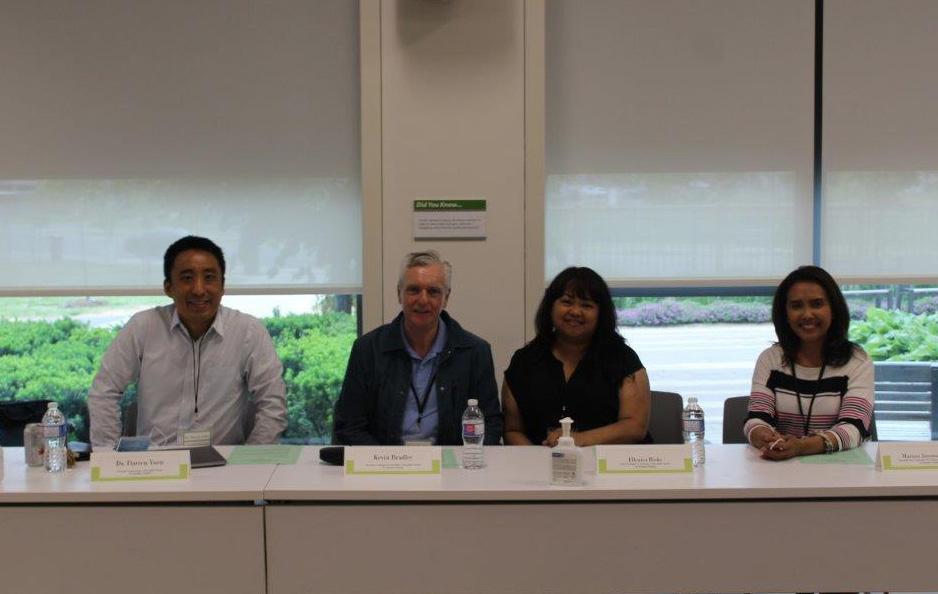
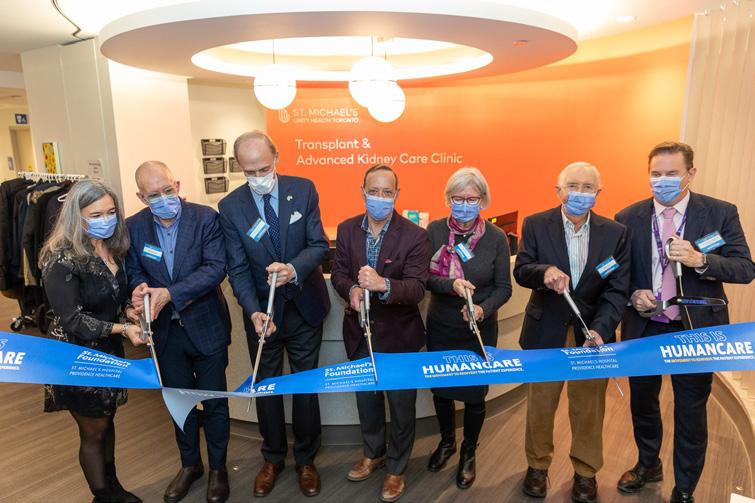


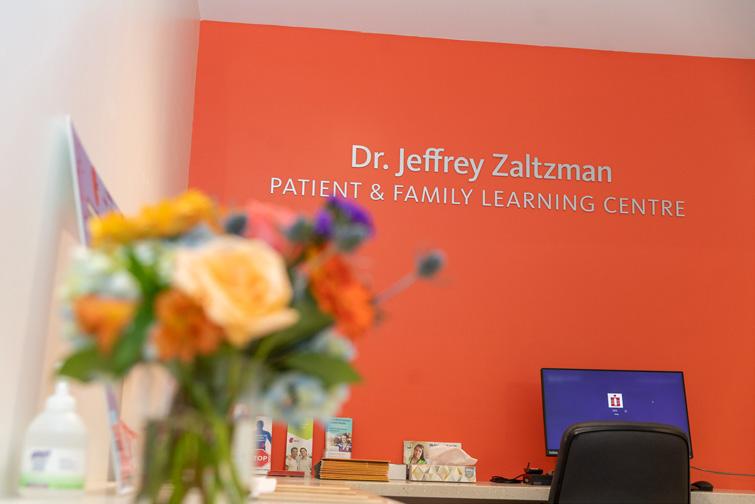
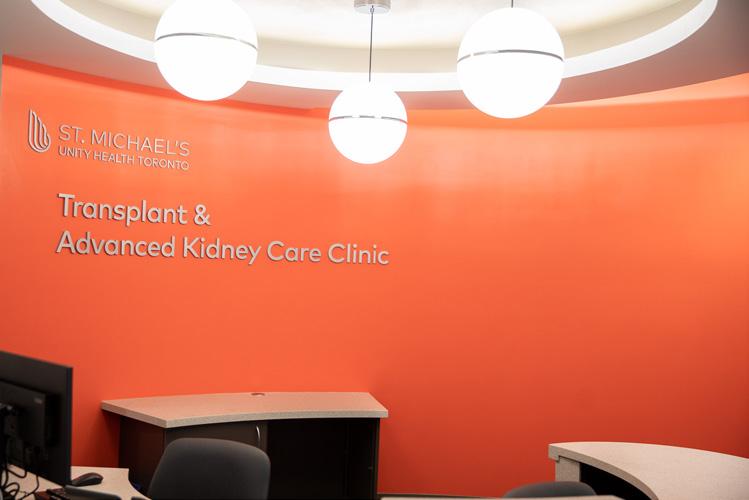

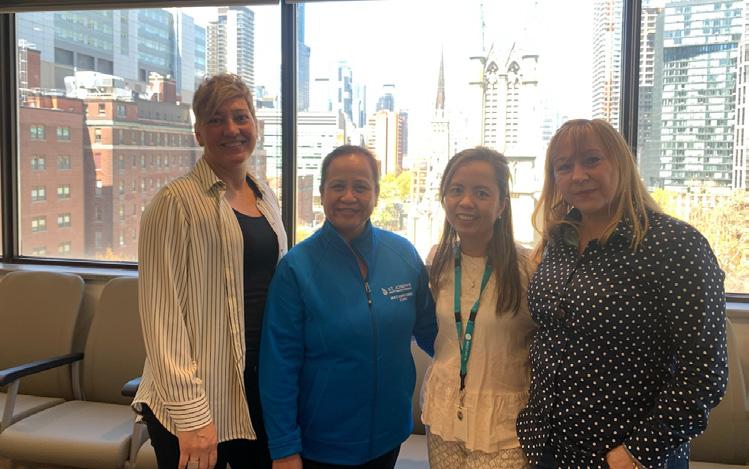

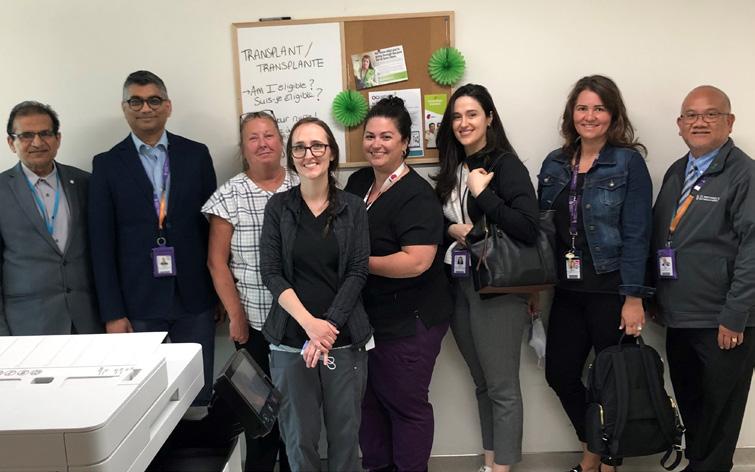
Choose the best answer for each question
1. To which body part is a kidney transplant NOT attached?
Bladder
external iliac artery
external iliac vein
old kidneys
2. How many transplants do we typically perform at St. Michael’s Hospital each year? 10-20 100-200 500-1000 1000-2000
3. What is the average length of stay in hospital after a kidney transplant?
One day
5-7 days a month a year
4. What is the average survival of a living donor kidney transplant?
One year
Three years
Ten years
Twenty years
5. What is considered a side effect of living donation?
6. Which form of cholesterol is considered “good”? HDL LDL non-HDL triglycerides
7. Which of these foods is considered a low potassium food? Banana orange tomato cabbage
8. When are the staples removed after the kidney transplant operation?
3-4 weeks
6-8 weeks
10-12 weeks
12-16 weeks
9. Patients with low levels on this test should not take dapsone, which is an alternative antibiotic to septra
10. The next Canadian Transplant Games will be held in August 2024 in